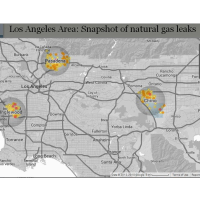Looking for Methane Leaks in L.A. County? There’s a Map for That
 (map: Environmental Defense Fund)
(map: Environmental Defense Fund)
If aging natural gas lines in Chino, Pasadena and Inglewood are any indication, the Los Angeles region has a lot of methane leaks.
Researchers for the Environmental Defense Fund (EDF) stuck their tracking equipment on Google Street View mapping cars, gathered information from more than 1,100 miles of driving and mapped it. They found 250 leaks—a methane leak, on average, every four miles in Pasadena and every five miles in the other two cities.
“Results like these are not unusual for utilities operating older systems in large metropolitan areas,” EDF wrote when it released the maps Thursday. And, indeed, EDF found similar results when they mapped Boston, Burlington, Indianapolis, Staten Island and Syracuse.
EDF turns its mapping information over to local utilities for their own use. In L.A., that is Southern California Gas Company (SoCalGas), which happened to release its own maps of leaks deemed non-hazardous. The hazardous ones are said to be addressed immediately and don’t appear on maps.
Methane is a big contributor to climate change and California is the nation’s second-largest consumer with more than 100,000 miles of pipelines. Sixty-seven million homes in U.S. cities use natural gas. So do 5 million businesses, schools and other buildings.
Around half the methane emitted in the Los Angeles area comes from wastes and 30% from oil and gas. But statewide, agriculture and dairies generate 60% of the gas, 25% is from wastes and 10% from oil and gas.
California’s Air Resource Board calculated that oil and gas operations of all kinds gave off around 140,000 metric tons of methane in 2012, according to EDF. That would supply almost 160,000 homes.
EDF played up waste, health issues (like asthma) and the environmental harm done by leaks but downplayed any immediate hazard: “Most leaks don’t pose an immediate threat to safety,” and “none of the leaks (pdf) identified in this study would be allowed to persist if they posed an imminent threat.”
That’s good news, but not everyone seems that assured. “We have a ticking time bomb under most of our cities, especially in the Northeast where we have older cities,” Allentown, Pennsylvania Mayor Ed Pawlowski told the Pittsburgh Tribune-Review last year.
The newspaper said that natural gas explosions killed 120 people, injured more than 500 and caused $775 million in damage nationally since 2004. USA Today toted up 135 dead, 600 injured and $2 billion in property damage.
The U.S. natural gas distribution network is less than 6% cast iron and unprotected steel pipes, but they account for 95% of leaks. Utility companies stopped using those materials in the 1960s but they are costly to replace.
The Obama Administration announced last month that it wanted a new program to spend between $2.5 billion and $3.5 billion a year for 10 years on aging gas pipelines, while acknowledging that it would cost $270 billion to fix it all.
Politico reported that the White House was unlikely to get that money from the Republican Congress. House Majority Leader Kevin McCarthy (R-California) said the President should start the discussion by signing off on the Keystone XL oil pipeline, a scheme to ship tar sands, one of the “dirtiest” sources of petroleum on Earth, from Canada to the Gulf.
–Ken Broder
To Learn More:
Study Maps Hundreds of Methane Gas Leaks Under Streets in L.A. Region (by Tony Barboza, Los Angeles Times)
“Pipelines Blow Up and People Die” (by Elana Schor and Andrew Restuccia, Politico)
Aging Natural Gaslines Pose Hidden Threat Across U.S. (by Mike Wereschagin, Pittsburgh Tribune-Review)
Look Out Below: Danger Lurks Underground from Aging Gas Pipes (by John Kelly, USA Today)
Los Angeles Area: Snapshot of Natural Gas Leaks (Environmental Defense Fund)
EDF Teams with Google Earth Outreach to Map and Measure Underground Methane Leaks from Southern California’s Natural Gas System (Environmental Defense Fund)
Quadrennial Energy Review: Energy Transmission, Storage and Distribution Infrastructure (U.S. Department of Energy) (pdf)
- Top Stories
- Controversies
- Where is the Money Going?
- California and the Nation
- Appointments and Resignations
- Unusual News
- Latest News
- California Forbids U.S. Immigration Agents from Pretending to be Police
- California Lawmakers Urged to Strip “Self-Dealing” Tax Board of Its Duties
- Big Oil’s Grip on California
- Santa Cruz Police See Homeland Security Betrayal in Use of Gang Roundup as Cover for Immigration Raid
- Oil Companies Face Deadline to Stop Polluting California Groundwater





